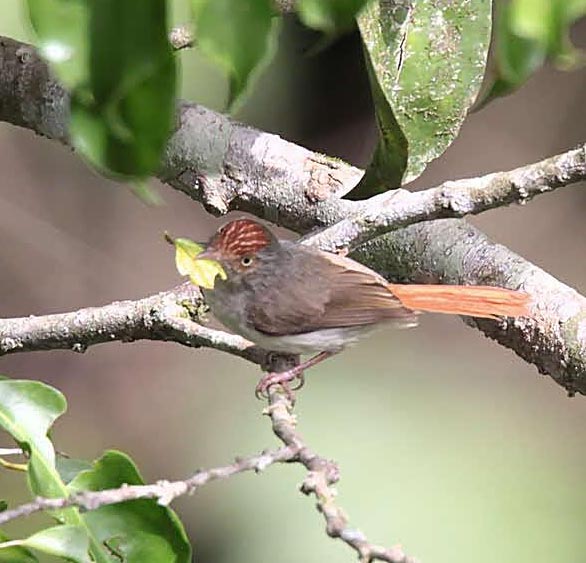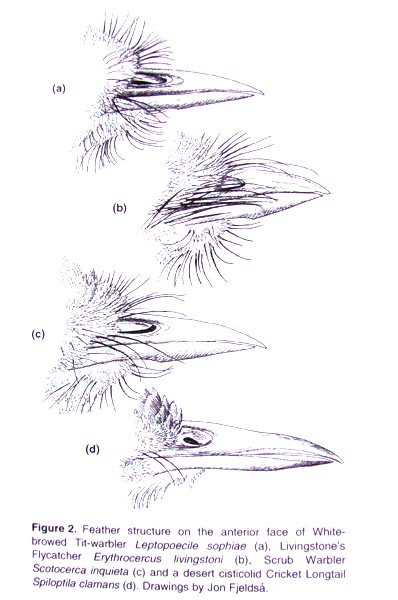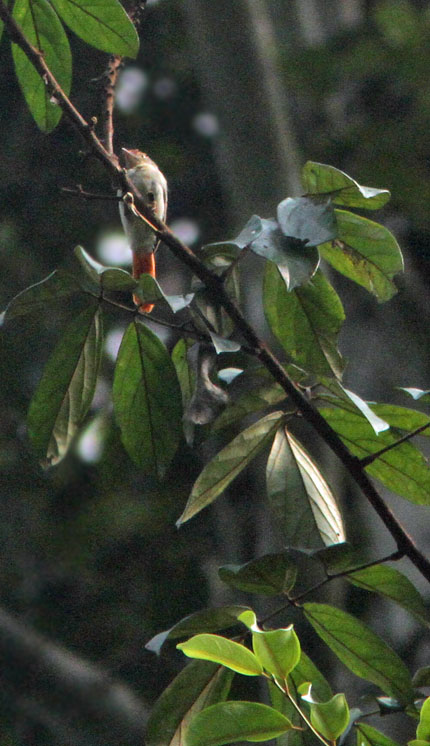
a web page by Don Roberson |
YELLOW FLYCATCHERS Erythrocercidae |
|
This bird, along with Yellow Flycatcher E. holochlorus of coastal forests from s. Kenya to ne. Tanzania, and Livingstone's Flycatcher E. livingstonei of se. Tanzania to Mozambique, and inland up the Zambezi River, have been traditionally placed with the monarch flycatchers [Monarchidae]; e.g., Coates et al. (2006). But Urban et al. (1997) raised questions about this placement, pointing out that their ball-shaped nest with side entrance was "unusual for a monarchine." Further, the "lack of turdine 'thumb' on the syrinx, [lack of] corvine configuration of humerus, and [lack of] monarchine nostril ossification raises questions about the real affinities of this genus. Remarkably, when the genetic evidence first was published (e.g., Alström et al. 2006, Jønsson & Fjeldså 2006), these three little flycatchers were shown to be entirely unrelated to monarch flycatchers or any other "flycatchers" at all. Instead, their closest relatives were warblers in the genus Cettia and related "warblers," and these "flycatchers" were assigned to the new family Cettiidae |
The paper by Alström et al. (2011) included detailed sketches of facial bristles in four small birds, three of them related to some close extent: White-browed Tit-warbler Leptopoecile sophiae, Livingstone's Flycatcher Erythrocercus livingstonei, Scrub Warbler Scotocerca inquieta, and Cricket Longtail Spiloptila clamans [top to bottom in Jon Fjeldså's illustration, right]. The point of this illustration was to show how different in facial bristles Scrub Warbler was from Cricket Longtail — which is a desert-loving member of the Cisticolidae — and how similar Scrub Warbler was to other relatives of the Cettiidae But the illustration also shows the extent of bristles at the base of the bill in the Erythrocercus flycatchers [as shown by Livingstone's Flycatcher, item (b) in the sketch]. I am unaware of any English name for the three Erythrocercus flycatchers as a set, but using the Latin would be a tongue-twister, and I suggest that perhaps these three small African flycatchers might be termed "bristle-flycatchers." There are other flycatchers with bristles — so the name should not imply this is a unique character — but it is a distinctive character of this group that helps illustrate their relationship to Scrub Warbler, the Cettiidae, and, for that matter, the long-tailed tits [family Aegithalidae] of which White-browed Tit-warbler is a member, as contrasted to other non-related groups. |
| UPDATE: In 2024, Clements/eBird and IOC elevated these flycatchers to Family status, but they prefer to call them "Yellow Flycatchers," so I follow. The following paragrapsh were written by me in 2012, providing an argument for elevating the Yellow Flycatchers to Family status but relegating Scrub Warbler Scotocerca inquieta to either a subfamily or just place it among the cettid bush warblers. Now that Yellow Flycatchers are currently a Family level group, this discussion is superfluous. Yet, I include this discussion for historical background purposes. |
In 2012, some of the authors of Alström et al. (2011), together with additional co-authors, published an on-line paper on the family relationships within the superfamily Sylvioidae (Fregin et al. 2012). This paper incorporated previous molecular studies with new evidence, and undertook to discuss the ordinal status of various groups (clades) of birds that were the result of the break-up of the Old World warblers a half-decade ago. This paper, for example, agreed with Gelang et al. (2009) and Cibois et al. (2009) that the core babblers should be broken up into three families: Timaliidae, Pellorneidae, and Leiothrichidae. In contrast, an independent review of the core babblers (Moyle et al. 2012) confirmed the same basic molecular findings — included three distinct clades within the core babblers — but preferred to consider those groups subfamilies of the single family Timaliidae. Neither approach is right or wrong — both are equally consistent with the genetic evidence — but, rather, this is a matter of style in determining where to draw lines between families and subfamilies. Among the other proposals in Fregin et al. (2012) was that the monotypic Scrub Warbler "is better placed in a monotypic family rather than in Cettiidae. It is morphologically and ecologically highly divergent from the Cettiidae ... [and] is separated from the Cettiidae .. by a long internode." They formally proposed the name Scotocercidae for this new Family. Reaction to this proposal has been mixed. The IOC world checklist tentatively suggested that it might adopt this proposal. Jon Boyd's on-line world checklist rejected the proposal. The initial indications suggest that neither the Howard & Moore world checklist nor Clements world checklist would adopt the proposal, at least not without further analysis. Personally, I fear that raised taxa to Family status on nothing more than "separated from a [sister group] by a long internode" will devalue Family level status dramatically. If applied similarly across the many phylogenies now available in the published literature, the number of "Families" might double or triple. What not, instead, use Subfamilies for these divergent groups? Further, Fregin et al. (2012) do not present any evidence of the age of this "long internode." I have expressed a preference that Family level status to limited to those evolutionary clades that have been evolving separately since the early Miocene (16-23 mya at the youngest) and that Family level groups be distinctive and definable. That the Scrub Warbler is "morphologically and ecologically highly divergent" from the Cettiidae sounds to me like a definition of birds within a Family, and not a definition of a Family. Indeed, just consider the morphological and ecological divergence among, say, the monarch flycatchers [Monarchidae] that include long-tailed canopy dwelling paradise-flycatchers in verdant jungles of tropical Africa to ground-dwelling arid-loving Magpie-lark of Australia, not to mention the Torrent-lark along rushing montane streams in New Guinea.
This proposal has generated the same diverse array of response as that of elevating Scrub Warbler to Family status, but I see the situations as not necessarily equivalent. First, the Yellow Flycatchers were not separated from their nearest relatives by just one "long internode" but they are separated from a clade composed of Cettiidae plus Scrub Warbler by a long period of separate evolution. Second, although Scrub Warbler and the remaining Cetiidae share the character of just 10 rectices (Alström et al. 2011), the decidedly most distinctive Yellow Flycatchers have 12 rectrices. Third, although Fregin et al. (2012) did not estimate the ages of their various groups, the cladograms accompanying the paper suggest — when compared to other evidence on the age of clades presented in Moyle et al. (2012) — that the Yellow Flycatchers may have diverged in the early Miocene. Further, they are dramatically different than all the other "warblers" in the Cettiidae in their flycatching behavior, and are diagnosable on morphology. Coates et al. (2006) describes these three birds as very small, "somewhat warbler-like in appearance ... [with] bill short and broad, and the rictal bristles are long and well-developed." Compared to monarchs (to which we now know they are not related), the "tail is of midium length, proportionately shorter than that of other African monarchids, and, unlike the tail of those species of those species, it is not graduated; furthermore, the wing measurement is longer than the tail measurement." Behaviorly, they display a "tail-fanning" character, and "all three have a short erectile crest." Together, all these factors are dissimilar to the single "long internode" that is the only reason to propose Scrub Warbler as a Family. I see the Yellow Flycatchers as something "on the borderline" of a family, and therefore adopt this part of Fregin et al's (2012) proposals. If, for example, you chose to combine both Scrub Warbler and Yellow Flycatchers as part of an expanded Cettiidae, the next internode is the sister group of the undisputed Family level clade composed the Long-tailed Tits [Aegithalidae] plus the African endemic Hylia prasina; Fregin et al. (2012). If one accepts Hylia (Hylia prasina) and the closely related Tit-hylia (Pholidornis rushiae) as a potential Family (as I do here, tentatively), the apparent age of divergence in these groups supports Yellow Flycatchers [Erythrocercidae] as a Family. |
Photos: Ian Fulton photographed the Chestnut-capped Flycatcher Erythrocercus mccallii in Kakum NP, Ghana, in 2007. My more distant shot of Chestnut-capped Flycatcher was in the Nsutu Forest, Ghana, on 6 Dec 2013.
Bibliographic note: There is no "family book" but a fine introduction to the three Yellow Flycatchers (as members of the Monarchidae in the HBW series) is in Coates et al. (2006). Literature cited:
|
 Three small African 'flycatchers' in genus Erythrocercus have traditionally been little more than an obscure footnote. All are lowland forest species; the most widespread is Chestnut-capped Flycatcher (left, in a fine shot by Ian Fulton from Ghana). It ranges from the forests of west Africa into the Congo Basin all the way from Cameroon and Gabon to the Budongo Forest of western Uganda.
Three small African 'flycatchers' in genus Erythrocercus have traditionally been little more than an obscure footnote. All are lowland forest species; the most widespread is Chestnut-capped Flycatcher (left, in a fine shot by Ian Fulton from Ghana). It ranges from the forests of west Africa into the Congo Basin all the way from Cameroon and Gabon to the Budongo Forest of western Uganda.  Then, in 2011, Alström et al. (2011), researching a project on Scrub Warbler Scotocerca inquieta of north Africa and the Middle East, found that this wren-like warbler was not related to the cisticolas (as everyone had thought) but was, in fact, a sister taxa to the Cettiidae. Once the genetic evidence showed the relationship of Scrub Warbler and the rest of the Cettiidae, the authors found morphological similarities as well, including claw shape, toe pads, facial bristles, number of rectrices, and shape of the tail. Their genetic evidence also found that the Erythrocercus flycatchers were sister taxa to a clade that included the Cettiidae + Scrub Warbler. From these data, several world checklists (including this one last year) placed both Scrub Warbler and the Erythrocercus "flycatchers" in the Cettiidae
Then, in 2011, Alström et al. (2011), researching a project on Scrub Warbler Scotocerca inquieta of north Africa and the Middle East, found that this wren-like warbler was not related to the cisticolas (as everyone had thought) but was, in fact, a sister taxa to the Cettiidae. Once the genetic evidence showed the relationship of Scrub Warbler and the rest of the Cettiidae, the authors found morphological similarities as well, including claw shape, toe pads, facial bristles, number of rectrices, and shape of the tail. Their genetic evidence also found that the Erythrocercus flycatchers were sister taxa to a clade that included the Cettiidae + Scrub Warbler. From these data, several world checklists (including this one last year) placed both Scrub Warbler and the Erythrocercus "flycatchers" in the Cettiidae  As to those former "monarch-flycatchers," the three Erythrocercus flycatchers, Fregin et al. (2012) also propose elevating them to Family level status. They proposed the formal name Erythrocercidae for the Family. The authors state that "the same reasons apply" as to their proposed Scotocercidae, "although Erythrocercus is even more different morphologically." They go on to describe the Family as composed of "flycatcher-like warblers, with prominent bristles around the base of bill, moderately rounded tail with 12 rectrices." My distant shot of Chestnut-capped Flycatcher (right) shows it up at mid-canopy in primary rainforest in Ghana, sitting upright like other non-related flycatchers do, and with a long, rounded, rusty tail.
As to those former "monarch-flycatchers," the three Erythrocercus flycatchers, Fregin et al. (2012) also propose elevating them to Family level status. They proposed the formal name Erythrocercidae for the Family. The authors state that "the same reasons apply" as to their proposed Scotocercidae, "although Erythrocercus is even more different morphologically." They go on to describe the Family as composed of "flycatcher-like warblers, with prominent bristles around the base of bill, moderately rounded tail with 12 rectrices." My distant shot of Chestnut-capped Flycatcher (right) shows it up at mid-canopy in primary rainforest in Ghana, sitting upright like other non-related flycatchers do, and with a long, rounded, rusty tail.